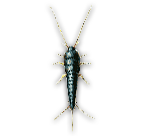Silverfish
Image is not to scale. |
General Characteristics: - Body length 10-12 mm - Body flattened, slender, silvery, gray, or blackish above, and pale below - Femora broad and flattened - Tip of abdomen with 1 long medial filament and 2 lateral cerci often as long as the medial one - Long thread-like antennae with many segments - Mandibles articulate at two points - Can run quickly but cannot jump - They are active at night, hide during the day, and avoid direct light Reproduction: - Female lays eggs continuously after reaching adulthood, and may lay over 100 eggs in total - Eggs are deposited singly or in small groups in cracks and crevices, and hatch in 3-6 weeks - Young are white initially, becoming silver within 4-6 weeks - Incomplete metamorphosis (egg, nymph, adult) - Adults continue to molt throughout their life, and may live 2-8 years
Signs of Infestation: - Found indoors in warm, damp environments such as bathrooms and kitchens, or in damp basements - Feeding off of crumbs and food scraps, dried meat, cereals, moist wheat flour - Also feed off of glue on book bindings and wallpaper, starch in clothing made of cotton or rayon fabric - Hidden in leaf litter, under rocks and logs, and in other natural crevices - When silverfish live indoors, they are most commonly found behind furniture, in books, and near sinks - They prefer temperatures that are 70 to 80 degrees. Control Techniques: - Ensure good sanitation practices are followed and floor is free of debris Lopez, M. 2001. "Lepisma saccharina" (On-line), Animal Diversity Web. Accessed January 12, 2010 at http://animaldiversity.ummz.umich.edu/site/accounts/information/Lepisma_saccharina.html. “Species Lepisma saccharina (Common Silverfish)” (On-line). Iowa State University Entomology. Accessed Jan.
|


